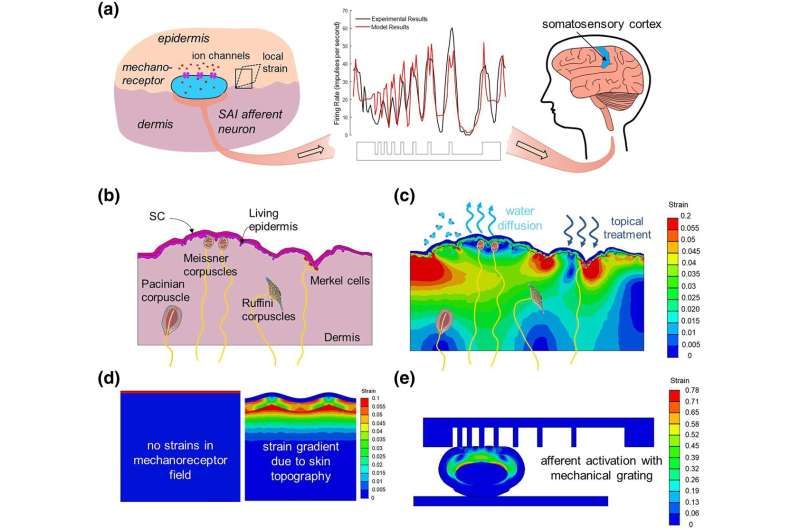This article has been reviewed according to Science X's editorial process and policies. Editors have highlighted the following attributes while ensuring the content's credibility:
fact-checked
peer-reviewed publication
trusted source
proofread
Research reveals why our skin feels 'tight' after washing

When we wash our face with a cleanser, our skin can start to feel tight. With the application of a favorite moisturizer, that feeling often goes away. This perception of our skin might seem subjective, but researchers at Stanford recently revealed the mechanism behind these feelings.
Their work, published in PNAS Nexus, demonstrates how mechanical changes at the outer surface of our skin translate into sensations and provides a quantitative approach for determining how people will perceive their skin after using a moisturizer or cleanser.
"This work provides a new understanding of how products affect the physical properties of our skin, which includes not just skin health, but also skin sensorial perception. That's a significant advance," said Reinhold Dauskardt, the Ruth G. and William K. Bowes Professor in Stanford's Department of Materials Science and Engineering. "It provides a whole new understanding of how to design those formulations."
Sensation prediction
Our skin is the largest organ in our body and it's constantly exposed to the environment around us. The outermost layer of our skin—the stratum corneum—acts as a barrier to keep out unwanted chemicals and bacteria and to keep in moisture. When we use a harsh cleanser, it strips away some of the lipids that hold in moisture, causing the stratum corneum to contract. A good moisturizer increases the water content of the stratum corneum, causing it to swell.
Dauskardt and his colleagues predicted that the mechanical forces created by this shrinking or swelling propagate through the skin to reach mechanoreceptors—sensory receptors that turn mechanical force into neurological signals—below the epidermis, which then fire off signals to the brain that we interpret as a feeling of skin tightness.
To test their theory, the researchers studied the effects of nine different moisturizing formulas and six different cleansers on donor skin samples from three locations on the human body—cheek, forehead, and abdomen. They measured changes in the stratum corneum in the lab and then fed that information into a sophisticated model of human skin to predict the signals that the mechanoreceptors would send.
"We were able to rank the different formulations in terms of what subjects should say about the sensorial perception of their skin," Dauskardt said.
The predictions from their analysis lined up almost perfectly with what people reported in human trials for each formula. Collaborators at L'Oréal Research and Innovation recruited 2,000 women in France to assess the nine moisturizers and 700 women in China to assess the six cleansers. The participants ranked their perceived feelings of skin tightness after using the formula they were given.
"We plotted what we were predicting against what human subjects were telling us, and it all fell on a straight line. In other words, we were predicting exactly what they were telling us," Dauskardt said. "It was an absolutely remarkable correlation with a very high statistical significance."
Shaping new developments
The ability to understand and predict how people will feel after using a skin treatment could help cosmetics companies improve their formulations before bringing in people to test them. And with such a detailed model of how mechanical stresses are transferred through skin layers, these methods could potentially be used to evaluate more than just the feeling of tightness, Dauskardt said.
"It provides a framework for the development of new products," Dauskardt said. "If you're doing anything to the outer layer of the skin that's causing it to change its strain state and its stress state, then we can tell you how that information is transmitted and how it will be understood and reported by consumers."
Dauskardt is also looking to apply this new understanding to the development of wearable devices. For example, if we know how our brains interpret minute changes in skin tension, we might be able to harness that mechanism to send intentional signals. In the same way that a person reading braille translates sensations on their fingertip into words, a device creating tiny mechanical changes on our skin might be able to convey information.
"What we've done is reveal how mechanical information gets from the outer stratum corneum layer down to the neurons much lower in the skin layers," Dauskardt said. "So now, can we communicate through human skin? Can we build a device to provide information to someone non-verbally, non-visually, using our understanding of these mechanisms? That's one of the areas we're very interested in."
Dauskardt is a member of Stanford Bio-X , the Cardiovascular Institute, the Wu Tsai Human Performance Alliance, and the Wu Tsai Neurosciences Institute, and an affiliate of the Precourt Institute for Energy and the Stanford Woods Institute for the Environment.
Additional Stanford co-authors of this research include doctoral students Ross Bennett-Kennett and Joseph Pace. Other co-authors are from L'Oréal Research and Innovation.
More information: Ross Bennett-Kennett et al, Sensory neuron activation from topical treatments modulates the sensorial perception of human skin, PNAS Nexus, (2023) DOI: 10.1093/pnasnexus/pgad292. academic.oup.com/pnasnexus/art … /2/9/pgad292/7278834



















